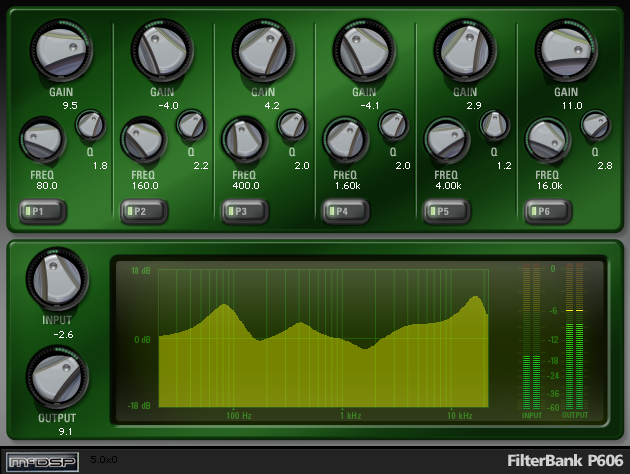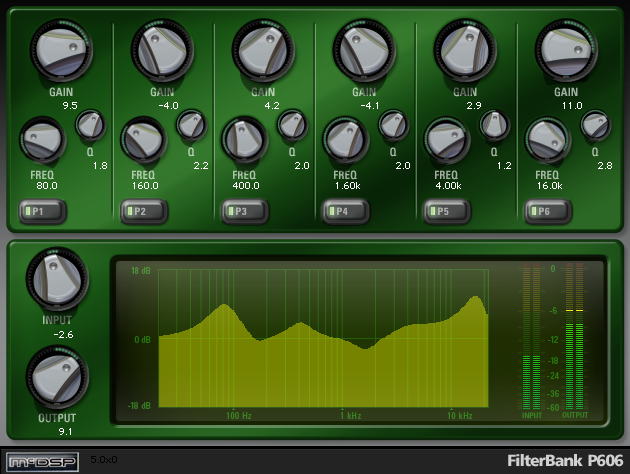
- Details
- Reviews
FilterBank is a high-end equalizer plug-in designed to emulate the sounds of vintage and modern equalizers and filters.
FilterBank is 3 plug-ins:
- E606 – parametric, high and low shelving EQ, high and low pass filters
- F202 – steep high and low pass filtering with resonant Q control
- P606 – parametric EQ with variable Q modes
Since it’s debut in 1998, FilterBank has become a legend within the audio community. With its unique Peak, Slope, Dip controls and variable Q modes FilterBank can emulate any EQ, or be used to create a distinct custom EQ.
FilterBank - Peak/Slope/Dip
The McDSP FilterBank v6 plug-in is a collection of 3 different EQ and filter configurations. Of these configurations, the E606 has an unique shelving EQ control set called Peak, Slope and Dip. These controls allow the user to customize the shelving EQ in a way only previously available to the EQ designers.
This issue focuses on the shelving EQ Peak, Slope, and Dip (PSD) control set and how they can be used in audio production.
Peak Slope and Dip Basics
Peak is the over shoot in the boost/cut portion of the shelving EQ frequency response. Peak is useful in adding ‘punch’ to the shelving EQ. A little bit of overshoot in the shelved band really helps the effect of the shelving EQ come through a mix. A judicious amount of Peak might offset the need for more shelving gain, and can allow the user to combine a shelf and nearly parametric response into a single band of EQ.
Dip is the under shoot in the non-boost/cut (i.e. the flat unaffected portion) of the shelving EQ frequency response. Dip works well to mask away the non-shelved portion of the frequency spectrum just above a low shelf boost (or just below a high shelf boost). As you increase the presence of some frequencies, it’s a good idea to reduce the amount of signal content just above/below the shelving response. This allows you to boost less because you are also cutting away some portion of the frequency spectrum – almost like an intelligent EQ!
Slope is the transition between the shelved and non-shelved portion of the frequency response. A more gradual Slope setting (50% or less) gives a smoother response – nice for boosting the high end of a piano track. Steeper Slope settings (75% and greater) provide a tighter response – good for bringing out kick drums or hi-hats. Note that the effect of the Peak and Dip controls is reduced as the Slope becomes more gradual. Peak and Dip have no effect on the shelving EQ shape when the Slope control is at its minimum setting (0%).
Peak Slope and Dip Applications
FilterBank is still, nearly 8 years after its release, the only EQ in hardware of software to offer the user complete control over the basic design elements of any shelving EQ with its unique Peak, Slope, and Dip controls. What does this mean for audio production? Here are some examples.
Kick and Snare Separation
Typical music styles call for a good ‘thud’ from the kick drum. A good solution for such sounds is a low shelf EQ. But as the kick is being boosted, the snare sound should not get the same treatment. For that matter, the ‘thud’ of the kick should not compete with the ‘thwack’ of the snare. Using the low shelf, the kick is boosted for a nice ‘thud’.
Hi-Hat, Cymbals
The Peak, Slope, and Dip controls are not only good for getting surgical as in the above example. These controls can allow the same shelving EQ gain and frequency settings to have a variety of tones. In the examples below the same drum kit is processed with some high shelf EQ, but with different variations of Peak, Slope, and Dip.
Classical Guitar Air
Some folks refer to the high shelf boost as adding ‘air’ to a track. As shown with the Hi-hat and Cymbals example above, a variety of tones are obtained using the Peak, Slope, and Dip controls in FilterBank.
| Product Name | McDSP FilterBank Native |
|---|---|
| Brand | MCDSP |
| Condition | New |
| MPN | M-PI-FBN-E |
| Shipping Option | Electronic Delivery |
McDSP FilterBank Native
FilterBank is a high-end equalizer plug-in designed to emulate the sounds of vintage and modern equalizers and filters.
FilterBank is 3 plug-ins:
- E606 – parametric, high and low shelving EQ, high and low pass filters
- F202 – steep high and low pass filtering with resonant Q control
- P606 – parametric EQ with variable Q modes
Since it’s debut in 1998, FilterBank has become a legend within the audio community. With its unique Peak, Slope, Dip controls and variable Q modes FilterBank can emulate any EQ, or be used to create a distinct custom EQ.
FilterBank - Peak/Slope/Dip
The McDSP FilterBank v6 plug-in is a collection of 3 different EQ and filter configurations. Of these configurations, the E606 has an unique shelving EQ control set called Peak, Slope and Dip. These controls allow the user to customize the shelving EQ in a way only previously available to the EQ designers.
This issue focuses on the shelving EQ Peak, Slope, and Dip (PSD) control set and how they can be used in audio production.
Peak Slope and Dip Basics
Peak is the over shoot in the boost/cut portion of the shelving EQ frequency response. Peak is useful in adding ‘punch’ to the shelving EQ. A little bit of overshoot in the shelved band really helps the effect of the shelving EQ come through a mix. A judicious amount of Peak might offset the need for more shelving gain, and can allow the user to combine a shelf and nearly parametric response into a single band of EQ.
Dip is the under shoot in the non-boost/cut (i.e. the flat unaffected portion) of the shelving EQ frequency response. Dip works well to mask away the non-shelved portion of the frequency spectrum just above a low shelf boost (or just below a high shelf boost). As you increase the presence of some frequencies, it’s a good idea to reduce the amount of signal content just above/below the shelving response. This allows you to boost less because you are also cutting away some portion of the frequency spectrum – almost like an intelligent EQ!
Slope is the transition between the shelved and non-shelved portion of the frequency response. A more gradual Slope setting (50% or less) gives a smoother response – nice for boosting the high end of a piano track. Steeper Slope settings (75% and greater) provide a tighter response – good for bringing out kick drums or hi-hats. Note that the effect of the Peak and Dip controls is reduced as the Slope becomes more gradual. Peak and Dip have no effect on the shelving EQ shape when the Slope control is at its minimum setting (0%).
Peak Slope and Dip Applications
FilterBank is still, nearly 8 years after its release, the only EQ in hardware of software to offer the user complete control over the basic design elements of any shelving EQ with its unique Peak, Slope, and Dip controls. What does this mean for audio production? Here are some examples.
Kick and Snare Separation
Typical music styles call for a good ‘thud’ from the kick drum. A good solution for such sounds is a low shelf EQ. But as the kick is being boosted, the snare sound should not get the same treatment. For that matter, the ‘thud’ of the kick should not compete with the ‘thwack’ of the snare. Using the low shelf, the kick is boosted for a nice ‘thud’.
Hi-Hat, Cymbals
The Peak, Slope, and Dip controls are not only good for getting surgical as in the above example. These controls can allow the same shelving EQ gain and frequency settings to have a variety of tones. In the examples below the same drum kit is processed with some high shelf EQ, but with different variations of Peak, Slope, and Dip.
Classical Guitar Air
Some folks refer to the high shelf boost as adding ‘air’ to a track. As shown with the Hi-hat and Cymbals example above, a variety of tones are obtained using the Peak, Slope, and Dip controls in FilterBank.
| Product Name | McDSP FilterBank Native |
|---|---|
| Brand | MCDSP |
| Condition | New |
| MPN | M-PI-FBN-E |
| Shipping Option | Electronic Delivery |
- Choosing a selection results in a full page refresh.
- Opens in a new window.

